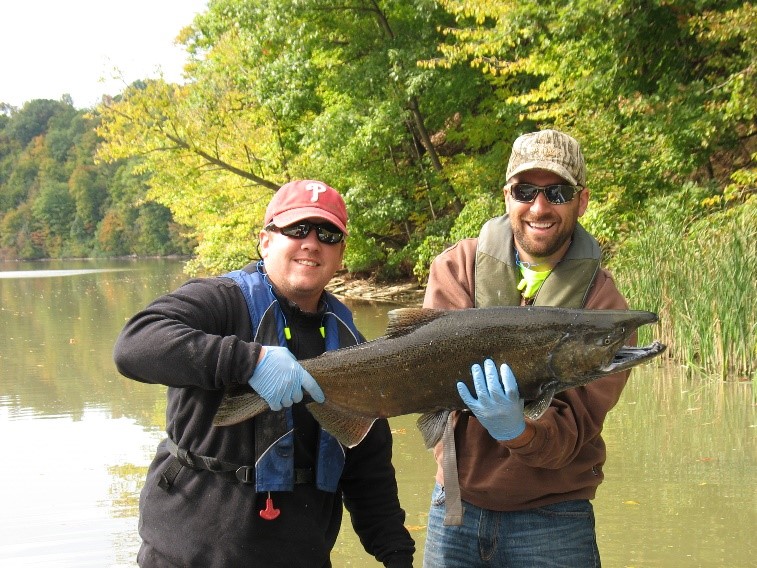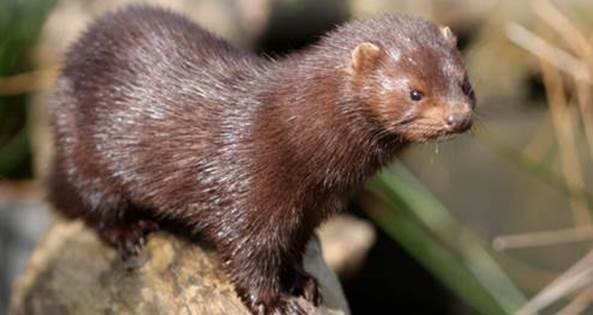U.S. EPA News Release:
EPA Confirms Habitat Improvements at Rochester Embayment Area of Concern in New York
11 of 14 Beneficial Uses Now Restored

NEW YORK (September 1, 2021) – Today, the Environmental Protection Agency announced that habitat for mink and bottom-dwelling aquatic plants and animals has improved to the point where the Degradation of Fish and Wildlife Populations Beneficial Use Impairment, or BUI, can be removed from in the Rochester Embayment Area of Concern. The area of concern is a 35-square mile portion of Lake Ontario. After years of work, including remediation and safeguard efforts, environmental monitoring shows that the removal criteria set by the State of New York has been met. Chinook salmon captured during a fish community survey Photo Credit: NYS DEC
Research shows that healthy mink now reproduce in Rochester Bay. Another study confirms that the habitat is also healthier for bottom-dwelling animals, plants and organisms. Over the last decade, EPA and its federal, state and local partners have completed several projects to improve the condition of sediment, restore wetlands and improve habitat throughout the AOC.
“These habitat improvements are important for the many species that depend on Lake Ontario to thrive and Rochester and Monroe County communities committed to seeing better water quality in the lake,” said EPA acting Regional Administrator Walter Mugdan. “Today’s news demonstrates EPA’s commitment to protecting and restoring the Great Lakes, which is only possible with strong partnerships at every level of government and with local communities.”
New York State Department of Environmental Conservation (DEC) Commissioner Basil Seggos said, “Today marks a key milestone in the restoration of the Rochester Embayment and another critical step forward advancing New York’s sustained progress improving Lake Ontario’s water quality and enhancing wildlife habitat. With our local, state, and federal partners, DEC is proud of our work cleaning up sediment and overseeing remediation in the Lower Genesee River that led to this moment, and we are committed to our common goal of restoring Lake Ontario.”
- Using Great Lakes Restoration Initiative, or GLRI, funding, U.S. Army Corps of Engineers constructed a 1,695-foot barrier island at the mouth of Braddock Bay and restored 340 acres of emergent and submergent marsh areas.

- Habitat restoration work at Braddock Bay, New York. Photo Credit: U.S. Fish and Wildlife Service
- Using GLRI funding, U.S. Fish and Wildlife Service created 15.4 acres of pothole habitat and 16 acres of habitat mounds in the confluence of West and Salmon creeks, Lower Salmon Creek, Long Pond West, Buck Pond East and the north portion of Braddock Bay. In addition, 65 acres of wetland were restored or enhanced, and 1,800 linear feet of open water channels were restored.
- Using GLRI funding, Ducks Unlimited restored 175 acres of coastal marsh habitat, 40 acres of sedge meadow and seven acres of fish spawning pools at Buck Pond, Buttonwood Creek and Salmon Creek. Hydrological connectivity between these waterbodies and Lake Ontario was also restored
- New York State Department of Environmental Conservation dredged approximately 29,000 cubic yards of contaminated sediment from the Lower Genesee River and then capped the two dredged areas at Eastman-Kodak Business Park in Rochester.

Mink at the Rochester Embayment AOC Photo Credit: Brady Dilllsworth, NYS DEC
EPA, the State of New York and many partners are committed to restoring and protecting the Great Lakes as work continues to address three remaining BUIs in Rochester Bay:
- Degradation of Aesthetics
- Loss of Fish and Wildlife Habitat
- Bird and Animal Deformities or Reproductive Problems
Launched in 2010, the GLRI is a results-driven program to protect and enhance the largest system of fresh surface water in the world. EPA and its partners have now removed 102 BUIs from AOCs in the U.S.
For more information see the Rochester Embayment AOC Degradation of Fish and Wildlife Populations BUI Removal Report, April 2021
Follow EPA Region 2 on Twitter at http://twitter.com/eparegion2 and visit our Facebook page, http://facebook.com/eparegion2
21-055 ###
No comments:
Post a Comment
Note: Only a member of this blog may post a comment.